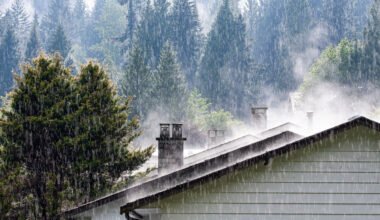Repetitive findings during property inspections denote the same fire safety mistakes time and again. Assessors and fire safety specialists essentially have a mental checklist of things they’re going to find because so many property owners across different inspectors fall into the same traps of non-compliance. Yet these traps are simple mistakes, not overly technical errors. They’re downright mistakes that shouldn’t be happening but still occur.
Therefore, understanding what assessors look out for will help landlords and others in property provision fix issues before they’re in danger of being noted for compliance or worse, becoming safety hazards. Patterns emerge and are clear, but those who own property fail to realize such patterns until obvious mistakes occur during an inspection that flag deficiencies requiring immediate resolution.
Alarms Too Old
One of the biggest findings during property inspections relates to alarms being too old. Alarms are only supposed to be good for about a decade. After about a decade, the sensors start to degrade and no longer will be registering smoke even if the test button works. Thus, with enough age, alarms still light up, and the red LED lights blink bright green. But there is nothing registering that they’ve gone bad.
What happens is alarms never announce when they reach this point. They still look fine, the test button works, and nothing suggests they’ve gone bad, even if it’s just from age. Therefore, landlords assume that if an alarm worked during last inspection, it should still work come the next inspection. However, inspectors will pull the manufacturing date and anything over ten years means replacement, regardless of how well it’s functioning.
But this catches a lot of people off-guard because the alarm looks great! Test button works, no one has tampered with it (or it’s in a remote enough location that it’s safe), and tenants have had no complaints. But age gets to everything, and inspectors know that age is one of the leading causes of failure when alarms are actually on and facing a fire. Therefore, replacing equipment when it’s due, not putting it off to check if it continues to work, is proper fire safety maintenance that many properties fail to acknowledge.
Inaccurate Placement
Alarms must be placed in specific locations to work well; however, it is common to find alarms in places where they either won’t work correctly or get disabled because they’re getting false alarms due to placement. Most commonly, alarms will be too close to kitchens (where heat alarms are needed instead), too far away from bedrooms (people sleep in rooms, not hallways, if someone is impaired from smoke, what help is an alarm in a hallway?), or just malfunctioning because they’re on walls instead of ceilings.
Each type of room has different requirements. For example, kitchens should have heat alarms instead of smoke alarms so people can determine whether they’re burning their food or if they have a real issue on their hands with a potential fire. Hallways and landings need alarms placed to track smoke coming from any room within the vicinity. And bedrooms ought to have alarms inside them instead of just relying on hallway alarms, especially in larger properties where a hallway alarm might not be loud enough to wake everyone.
For housing professionals managing many properties, this becomes evident quite quickly. Fire and CO safety for UK trade and housing professionals need to be aware of not only equipment to be purchased and applied but also proper placement without nuisance alarm issues to prevent disabling systems that ultimately make them less useful than if people had done nothing in the first place.
Coverage Gaps
Alarms should be everywhere, but inspections regularly find homes that have gaps in coverage where certain places within a property do not have fire detection at all. This happens frequently with conversions or extensions or homes where room usage has changed since initial alarm installation. A loft conversion may have occurred but no alarms were added. A garage conversion happened but that’s still treated as garage space from a fire safety perspective, which doesn’t help when people are actually sleeping there.
For example, properties with multiple floors need coverage on every level; however, inspectors frequently find basements and attics with zero coverage whatsoever when these areas naturally need something as well. Stairwells need alarms; they serve as chimneys for smoke. Still, many homes only have them in hallways and bedrooms, and even that is still problematic because stairs generally have no protection whatsoever.
It’s common sense that coverage needs to be comprehensive. Fire can start anywhere; if there’s no alarm there, time is wasted before people are notified. By the time smoke travels to an alarm at another end of the house or upstairs from the basement, it’s often far too late for effective escape, even rendering escape routes gone.
CO Gaps
CO alarm requirements have gotten stricter over the years; however, properties have yet to catch up with them. Weekly inspections find homes with gas boilers or gas hobs and other fuel-burning appliances without a CO alarm OR CO alarms missing in rooms where they need to be throughout the home.
Regulations state that any rooms containing a fixed combustion appliance needs a CO alarm; inspectors often assume sleeping areas require them as well. But landlords who had installed CO alarms years prior relative to older safety suggestions do not realize their current setups no longer comply with standards set today versus five years ago.
CO protection becomes problematic in HMOs and student housing when those tenants use portable heaters or other tools that introduce CO risks that no one anticipated beforehand. The property may have been compliant as it was empty but tenant use presents new risks.
Interconnection Failures
Larger properties require interconnected systems, HMOs or otherwise, wherein one alarm going off brings all alarms down; inspectors often find interconnection failed, especially with wireless systems when they weren’t commissioned correctly or individual devices have been replaced over time without noting interconnected networks.
Testing shows this pretty quickly; someone can press one button and if all others don’t register, the system fails to provide the service it’s meant to provide. Surprisingly enough this happens more than people realize because superficial testing, just pressing one button, fails to spot the lack of interconnection.
Maintenance requires different attention levels; once something is interconnected, it’s important to maintain that status for when one alarm is replaced (properly related to its other components). Landlords often assume they can substitute something else different if it fits even if it electronically disconnects it from the networked system; this goes unnoticed until an inspector comes along.
Lack of Maintenance Records
Inspectors like to see paperwork proving testing has been done along the way; for example, notes that alarms have been tested or fire doors have been serviced or other safety precautions have been maintained prove helpful suggestions down the line.
Where things get problematic is when someone expects work machines like this but they cannot be found, there’s no paper trail showing any sort of consistent effort along the way, and this registers major red flags even if equipment looks good and functional upon testing.
A failure to provide documentation suggests a failure in general for fire safety instead of just an administrative oversight. If there is no testing record, inspectors fail to note it’s been tested because there are no timestamps. Even if a landlord says they’ve tested along the way there must be something tangible to provide as a proof, it also protects them against tenant malfeasance.
Records don’t need to be overly complicated or unique; basic entries that show timestamps for testing boast when certain equipment was tested along with results would suffice, when batteries were changed out or full units were replaced would also comply with minimal paper trails required along the way.
Tenant Interference
Tenants are responsible for incorrect operations when it comes to fire safety machines as well. Alarms without batteries, alarms painted over, alarms with plastic bags over them, disconnected CO alarms all come up during inspections alongside blocked exit routes.
While this technically puts responsibility on tenants as they’ve interfered with these situations, ultimate responsibility falls on landlords as they’ve allowed it to exist without knowing better.
But this creates an unfortunate dynamic because tenant behavior can invalidate even the best installations possible. Therefore, inspections note how at least property visits help instead but ultimately no one can monitor tenant activity at all times, what they’re really asking landlords is if they have systems in place to understand problems on their own during routine visits and what they do about issues coming up.
Avoidance
The fire safety mistakes that keep showing up are predictable based on repetitive assessments given during inspections. They are avoidable problems stemming from inadvisable installation efforts or inappropriate ongoing maintenance efforts or avoidance efforts, or adjustment efforts relative to years passing that could turn out code compliance for no extra charge.
Those who understand common findings can audit their own solutions before official assessments do if they make their issues obvious before inspectors arrive.
It’s not enough for aesthetic purposes but primarily for any hope of legitimate fire safety protection for tenants who’ve trusted their rental accommodations meet basic safety standards. Thus, knowing what inspectors look for will help suggest systems are in place and effective rather than merely installed and ignored as ineffective tools because equipment that’s too old and improperly placed provides false sense of security that’s arguably worse than nothing at all because everyone assumes they’re protected when they’re really not even close.



